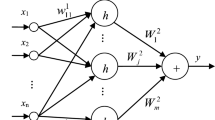Abstract
This paper presents a simple and efficient method based on artificial neural network to solve distributed optimal control of Poisson’s equation with Dirichlet boundary condition. The trial solutions are used to approximate the state and control variables. These trial solutions are considered by using a single layer neural network. By replacing the trial solutions in objective function and Poisson’s equation, then using the weighted residual method, distributed optimal control of Poisson’s equation is converted to a linear quadratic optimal control problem. The weights of the trial solutions are computed by solving the new problem. In order to solve the linear quadratic optimal control problem, the Pontryagin maximum principle is used. Finally we apply the proposed method on several examples that in computational experiments, the high efficiency of the presented method is illustrated.








Similar content being viewed by others
References
Aarts LP, Van Der Veer P (2001) Neural network method fors olving partial differential equations. Neural Process Lett 14:261–271
Alli H, Ucar A, Demir Y (2003) The solutions of vibration control problems using artificial neural networks. J Frankl Inst 340(307):325
Altrogge I, Preusser T, Kröger T, Büskens C, Pereiran PL, Schmidt D (2007) Multiscale optimization of the probe-placement for radio-frequency ablation. Acad Radiol 14:1310–1324
Apel T, Flaig TG (2009) Simulation and mathematical optimization of the hydration of concrete for avoiding thermal cracks. In: 18th International conference on the application of computer science and mathematics in architecture and civil engineering
Chen CT (1995) Linear system theory and design. Oxford University Press Inc, Oxford
Cheng T, Lewis FL, Abu-Khalaf M (2007) A neural network solution for fixed-final time optimal control of nonlinear systems. Automatica 43:482–490
Cybenko G (1989) Approximation by superpositions of a sigmoidal function. Math Control Signals Syst (MCSS) 2:303–314
Dissanayake MW, Phan- Thien N (1994) Neural network based approximations for solving partial differential equations. Int J Numer Methods Biomed Eng 10:195–201
Effati S, Pakdaman M (2013) Optimal control problem via neural networks. Neural Comput Appl 23:2093–2100
Finlayson BA (1972) The method of weighted residuals and variational principles. Academic Press, New York
Golub GH, Welsch JW (1969) Calculation of gauss quadrature rules. Math Comput 23:221–230
Hinze M, Pinnau R, Ulbrich M, Ulbrich S (2009) Optimization with PDE constraints. Springer
Kamyad AV, Skandari MHN, Erfanian HR (2011) A new definition for generalized first derivative of nonsmooth functions. Appl Math 2:1252–1257
Kierzenka J (1998) Studies in the numerical solution of ordinary differential equations. Ph.D. Thesis, Southern Methodist University
Lagaris IE, Likas A, Fotiadis D (1998) Artificial neural networks for solving ordinary and partial differential equations. IEEE Trans Neural Netw 9:987–1000
Lions JL (1968) Optimal control of systems. Springer, New York
Naidu DS (2002) Optimal control systems. CRC Press, New York
Pearson JW, Wathen AJ (2012) A new approximation of the Schur complement in preconditioners for PDE-constrained optimization. Numer Linear Algebra Appl 19:816–829
Pearson JW (2013) A radial basis function method for solving PDE-constrained optimization problems. Numer Algorithms 64:481–506
Rees T, Dollar HS, Wathen AJ (2010) Optimal solvers for PDE-constrained optimization. SIAM J Sci Comput 32:271–298
Rudin W (1991) Functional analysis. International series in pure and applied mathematics. McGraw-Hill Inc, New York
Rudd K, Ferrari S (2015) A constrained integration (CINT) approach to solving partial differential equations using artificial neural networks. Neurocomputing 155:277–285
Sandberg EW (1998) Notes on uniform approximation of time-varying systems on finite time intervals. IEEE Trans Circuits Syst I Fundam Theory Appl 45:863–865
Shampine L, Kierzenka J, Reichelt M (2011) Solving boundary value problems for ordinary differential equations in Matlab with bvp4c, 2000. http://www.mathworks.com/matlabcentral/fileexchange/3819. Taken on June 6, pp 1–30
Tröltzsch F (2010) Optimal control of partial differential equations. Graduate studies in mathematics, vol 42. American Mathematical Society
Wang X, Shimizu K (2001) Approximate solution of Hamilton Jacobi Bellman equation by using neural networks and matrix calculus techniques. IEICE Trans Fundam Electron Commun Comput Sci 84(6):1549–1556
Yanping C, Yi N, Liu W (2008) A Legendre–Galerkin spectral method for optimal control problems governed by elliptic equations. SIAM J Numer Anal 46:2254–2275
Yanping C, Xia N, Yi N (2011) A Legendre Galerkin spectral method for optimal control problems. J Syst Sci Complex 24:663–671
Author information
Authors and Affiliations
Corresponding author
Rights and permissions
About this article
Cite this article
Ghasemi, S., Effati, S. An Artificial Neural Network for Solving Distributed Optimal Control of the Poisson’s Equation. Neural Process Lett 49, 159–175 (2019). https://doi.org/10.1007/s11063-018-9806-8
Published:
Issue Date:
DOI: https://doi.org/10.1007/s11063-018-9806-8




